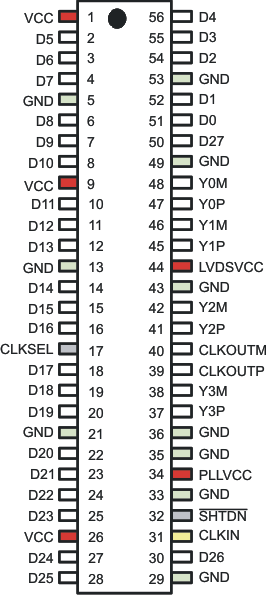SLLS980E June 2009 – November 2016 SN75LVDS83A
PRODUCTION DATA.
- 1 Features
- 2 Applications
- 3 Description
- 4 Revision History
- 5 Description (continued)
- 6 Pin Configuration and Functions
- 7 Specifications
- 8 Parameter Measurement Information
- 9 Detailed Description
- 10Application and Implementation
- 11Power Supply Recommendations
- 12Layout
- 13Device and Documentation Support
- 14Mechanical, Packaging, and Orderable Information
6 Pin Configuration and Functions
DGG Package
56-Pin TSSOP
Top View

Pin Functions
| PIN | TYPE(1) | DESCRIPTION | |
|---|---|---|---|
| NAME | NO. | ||
| CLKIN | 31 | I | CMOS with pulldown; input pixel clock; rising or falling clock polarity is selectable by Control input CLKSEL. |
| CLKOUTM | 40 | O | Differential LVDS pixel clock output. Output is high-impedance when SHTDN is pulled low (de-asserted). |
| CLKOUTP | 39 | O | |
| CLKSEL | 17 | I | CMOS with pulldown; selects between rising edge input clock trigger (CLKSEL = VIH) and falling edge input clock trigger (CLKSEL = VIL). |
| D0 | 51 | I | CMOS with pulldown; data inputs. To connect a graphic source successfully to a display, the bit assignment of D[27:0] is critical (and not necessarily intuitive). For input bit assignment, see Figure 14 to Figure 17 for details. Note: if application only requires 18-bit color, connect unused inputs D5, D10, D11, D16, D17, D23, and D27 to GND. |
| D1 | 52 | I | |
| D2 | 54 | I | |
| D3 | 55 | I | |
| D4 | 56 | I | |
| D5 | 2 | I | |
| D6 | 3 | I | |
| D7 | 4 | I | |
| D8 | 6 | I | |
| D9 | 7 | I | |
| D10 | 8 | I | |
| D11 | 10 | I | |
| D12 | 11 | I | |
| D13 | 12 | I | |
| D14 | 14 | I | |
| D15 | 15 | I | |
| D16 | 16 | I | |
| D17 | 18 | I | |
| D18 | 19 | I | |
| D19 | 20 | I | |
| D20 | 22 | I | |
| D21 | 23 | I | |
| D22 | 24 | I | |
| D23 | 25 | I | |
| D24 | 27 | I | |
| D25 | 28 | I | |
| D26 | 30 | I | |
| D27 | 50 | I | |
| GND | 5, 23, 21, 29, 43, 49, 53 |
P | Supply ground for VCC, LVDSVCC, and PLLVCC(2) |
| LVDSVCC | 44 | P | 3.3-V LVDS output analog supply(2) |
| PLLVCC | 34 | P | 3.3-V PLL analog supply(2) |
| SHTDN | 32 | I | CMOS with pulldown; device shut down; pull low (deassert) to shut down the device (low power, resets all registers) and high (assert) for normal operation. |
| VCC | 1, 9, 26 | P | 3.3-V digital supply voltage(2) |
| Y0M | 48 | O | Differential LVDS data outputs. Output is high-impedance when SHTDN is pulled low (deasserted). |
| Y0P | 47 | O | Differential LVDS data outputs. Output is high-impedance when SHTDN is pulled low (deasserted). |
| Y1M | 46 | O | Differential LVDS data outputs. Output is high-impedance when SHTDN is pulled low (deasserted). |
| Y1P | 45 | O | Differential LVDS data outputs. Output is high-impedance when SHTDN is pulled low (deasserted). |
| Y2M | 42 | O | Differential LVDS data outputs. Output is high-impedance when SHTDN is pulled low (deasserted). |
| Y2P | 41 | O | Differential LVDS data outputs. Output is high-impedance when SHTDN is pulled low (deasserted). |
| Y3M | 38 | O | Differential LVDS Data outputs. Output is high-impedance when SHTDN is pulled low (deasserted). Note: If the application only requires 18-bit color, this output can be left open. |
| Y3P | 37 | O | Differential LVDS Data outputs. Output is high-impedance when SHTDN is pulled low (deasserted). Note: If the application only requires 18-bit color, this output can be left open. |
(1) I = Input, O = Output, P = Power
(2) For a multi-layer PCB, TI recommends keeping one common GND layer underneath the device and connecting all ground terminals directly to this plane.